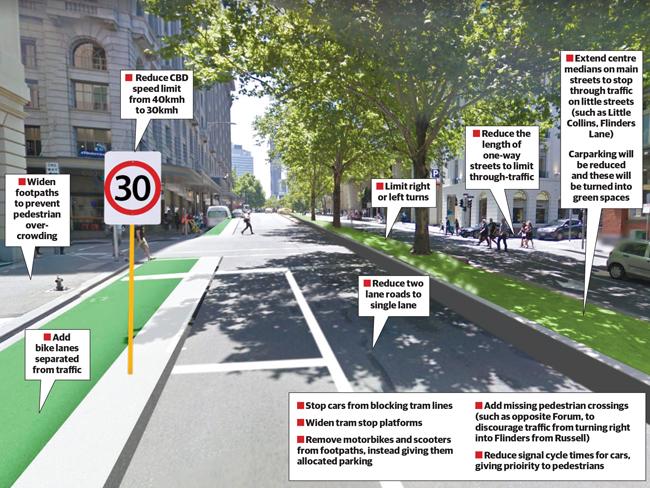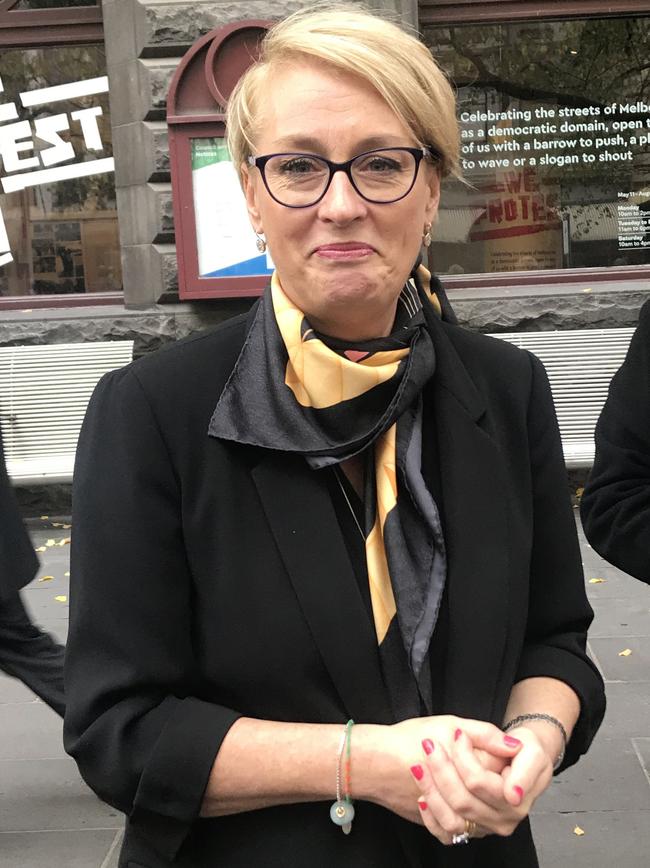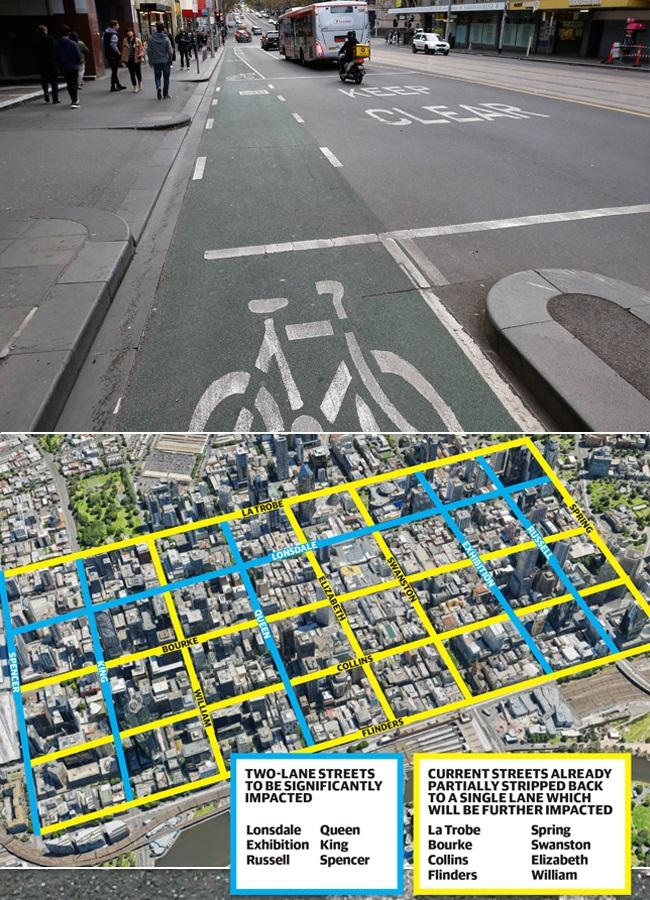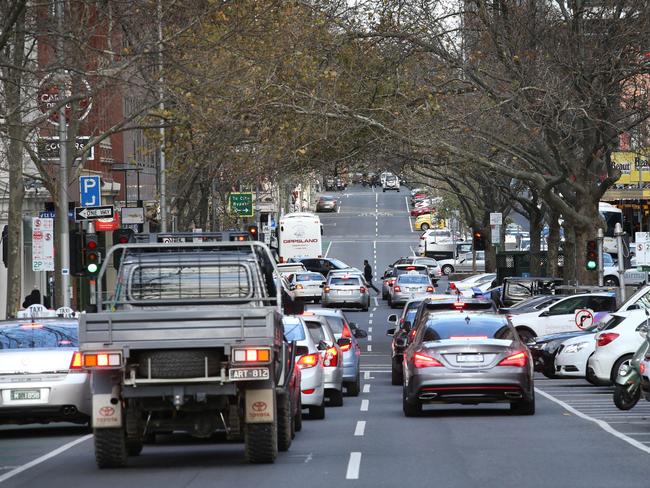Melbourne CBD road squeeze: Push for one lane each way on all main streets
MELBOURNE’S CBD streets would be reduced to a single lane each way and the speed limit slashed to 30km/h under a radical vision to drive cars out of the city centre. See the full details.
VIC News
Don't miss out on the headlines from VIC News. Followed categories will be added to My News.
EXCLUSIVE: MELBOURNE’S CBD streets would be reduced to a single lane each way and the speed limit slashed to 30kmh under a radical vision to drive cars out of the city centre.
Motorists would also face higher fees for on-street parking at busy times, while several left and right turns would be blocked.
The drastic measures to stop motorists crossing the Hoddle Grid — bounded by Flinders, La Trobe, Spencer and Spring streets — are being flagged by the City of Melbourne.
CAR-FREE ‘SUPER BLOCKS’ PROPOSED
COUNCIL FLAGS CONGESTION-BUSTING SCHEME
The options are outlined in two discussion papers released on Thursday for public consultation.
The feedback will be used to develop a new transport strategy focused on giving priority in the city to pedestrians, cyclists and public transport users.
Premier Daniel Andrews this morning said he did not support a move to drive cars from the city.
“The best way to get cars out of the city is to do exactly what we’re doing,” he said.
“That is, building the best public transport system anywhere in the world.”
Mr Andrews also warned of the bad timing with major construction, including on the Metro rail tunnel, temporarily closing roads and adding to congestion.
HOW CBD WOULD FEEL THE SQUEEZE

He said these works had also put “significant pressure” on the city.
“Not only do we not support these ideas, I don’t think this is the time for us to be making these sorts of changes,” he said.
“There is some congestion because of the construction work we are doing.
“Melbourne City Council are free to pursue these ideas but they are not ideas that the government supports.”
Opposition Leader Matthew Guy labelled the council’s plan as ridiculous.
“To try to ban cars from the CBD is really just another headline grabbing idea that really hasn’t had much thought,” he said.
Mr Guy said that if elected at the November state poll he would overturn the council’s strategy.
“I’m not going to ban cars from the CBD, it’s as simple as that,” he said.
“People need to get to work, people need to visit those who live in the CBD, and there are trucks that need to service all the businesses that are at home in our CBD - I mean, it doesn’t make any sense whatsoever.”
But Lord Mayor Sally Capp today denied that the council was anti-cars.
“We respect car drivers as much as we do every other mode of transport, and so I believe there will always be access to the city by car,” she said.
“We always have to have access for emergency services vehicles, for vehicles helping our disabled access our city, for tradespeople and deliveries.”
“The space that is of particular interest to us for discussion and debate is the space where the cars are stationary, and that is the on street parking...can we use that space better.”
Cr Nicolas Frances Gilley said that changes to better utilise road space for non-car modes of transport would benefit everybody.
“Actually, If you want to be in a car and you want to come into the city, what you want is us to be successful,” he said.
“You want more people walking, you want more people cycling and you want more people on the tram, because then the road’s clear.”
The discussion paper raises the possibility of stopping cars from using the Hoddle Grid to get across the city.
This would be achieved through measures such as limiting right and left turns and extending median strips across intersections with the “Little” streets — to stop cars being able to use them as through-roads.
One-way runs would also be reduced in length by switching the direction of traffic along certain stretches.

Other options floated to discourage cars from entering the CBD include drastically cutting on-street parking spaces, reducing traffic to one lane each way on all main streets, including at intersections, slashing the current 40kmh speed limit by 10kmh and making motorists wait longer at traffic lights.
RACV public policy general manager Bryce Prosser said trying to stop cars driving through the CBD posed a major engineering challenge.
“In these congested days … like most drivers, RACV doesn’t want to see unnecessary car trips,” he said.
“For Melbourne to work as a capital city, both council and state government must work together to provide alternative routes to journeys through the heart of the city which also integrate with public transport and bike access.”

Council transport portfolio chairman Nicolas Frances Gilley said that cities such as New York, Hamburg and Zurich had capped their parking supply.
“We need to change the way we think about carparking and ask ourselves if private vehicle storage is the best use of our most important public spaces,” he said.
“In San Francisco, they introduced dynamic pricing for on-street parking that increases with demand — this resulted in a 50 per cent reduction in drivers circulating streets searching for parking.”
Cr Frances Gilley said that apart from crucial exceptions such as deliveries, disability and emergency services, “we are in the business of reclaiming space from cars for great shared living”.
“We need to optimise our city streets for people walking, cycling and taking public transport, because that is how the majority of people move around, and it’s the most efficient way to move large numbers of people as our population grows,” he said.

A “what if”’ section of the “carparking” paper envisages a large number of on-street parking spaces converted to open space, trees, bike lanes and footpaths.
“New residential buildings near public transport were provided with car share instead of car storage, supporting sustainable travel,” it says.
“People without cars could buy cheaper apartments because all carparks were sold separately.”
The discussion paper says a cap on parking could help even out the oversupply of off-street parking spaces and improve occupancy in some areas of the street.
The paper says that more motorcycle use could benefit the city by taking up less space than cars, but parking on footpaths poses a risk to pedestrians as the city gets busier. “More motorcycle parking will be needed,’ it says.
COUNCIL EYEING MORE CITY SPACE
INNER Melbourne is set for a dramatic overhaul under the city council’s vision to keep cars out and create more space and safety for pedestrians and cyclists.
Most Melbourne city streets were designed for vehicles, but since 2001, the share of car trips to work has fallen by 28 per cent, while job numbers have jumped by 43 per cent.
While car use is declining, the number of people working, visiting or living in the municipality is expected to grow from 914,000 a day to 1.4 million per day by 2036.
“The central city will not be able to cater for this growth without major changes to the priority given to cars,” says a council discussion paper.
“The question is not whether this should change, but how much, when and where.”
The council wants the discussion papers released on Thursday to provoke debate as it presses the case for major changes to how inner-city traffic and space is managed.

It sees no alternative to significantly reducing the number of vehicle lanes and parking spaces and increasing parking fees at certain times to discourage car travel.
“Underused parking spaces should continue to be converted to other uses, but at a faster ate,” says the carparking paper.
“Higher-value uses of street space include more trees, wider footpaths, improved tram stops and on-street dining areas.
“The large amount of space dedicated to on-street parking provides a significant opportunity to increase tree canopy cover and mitigate climate change impacts.”
Council transport portfolio chairman Nicolas Frances Gilley said 57 per cent of street space in the municipality was now taken up by roads and 4 per cent is for on-street parking.
“That means over 60 per cent of the space is allocated to the 36 per cent of trips in and around the municipality made by private car. This is about redressing the balance,” he said.
The motor vehicle discussion paper says safety and security is a big challenge, with the CBD subject to deadly vehicle attacks in recent years resulting in the installation of bollards.
“More car-free places and less vehicles in the city will further reduce risk,” it says.
RACV public policy general manager Bryce Prosser said his organisation had long supported the conversion of on-street carparking to other purposes, including separated bike lanes, bus lanes and wider footpaths in busy locations.
“But council should act now to remove clutter from its busiest footpaths and not keep waiting for yet another plan,” he said. “Dynamic parking pricing will need to have safeguards to ensure surge costs are not out of line with community expectations. Cheaper pricing in quiet, less popular places makes sense.”
More details: participate.melbourne.vic.gov.au/transportstrategy


